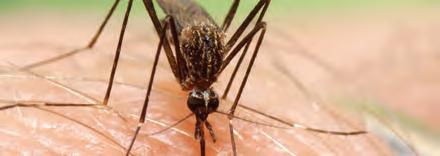
































Imarried a hottie.
He loves the heat and the sun.
When the summer sun is scorching and most people hide inside to keep from flash frying, he goes outside to do yard work.
I tend toward the cool side. Some like it hot, some like it cold, and for some mysterious reason they tend to marry one another.

his flannel-lined jeans, affectionately known as his stuffed scarecrow pants. He spent the bulk of summer outside and I spent the bulk of summer fanning myself in front of the freezer door.
Our favorite pastime is playing endless rounds of tag with the thermostat. Our banter over the temperature often sounds like a poker game. He says, “I’ll see your 68 and raise you six.”
“That’s 74,” I say. “I can’t do 74. I’m out.” And I will be out – passed out cold once the oppressive heat kicks in.
When summer heat arrived full force this year, I had to hide
After intense negotiations, we agreed on warmer temps inside the house during the daytime and lowering the thermostat at night. It’s a momentary truce in our cold war.
That said, I remain concerned when he is outside in blistering heat. When the sun hits the front porch, he goes out, sits in a wicker chair and reads. You know what happens when you read in the warm sun, right? You fall asleep. Your head drops, whatever you are reading falls from your hands and your upper body slumps.


DREAMSTIME/TNS
“Our banter over the temperature often sounds like a poker game,” writes Lori Borgman.
I tell him I am concerned about this because we have numerous runners, walkers and cars passing by our house.
He says I don’t need to be concerned; there is a second chair if



someone would like to join him. My concern is that if people see a man of a certain age slumped in a chair, they could think there is a medical emergency and call 911. Then a fire



truck and ambulance will roar up to the house with sirens screaming. I’ll run outside to see what is happening, see paramedics jerking him out of the wicker chair, then keel over from shock.
“Is that what you want?” I ask.
He says he can’t hear me. He is sitting in a patch of sunlight pretending to be asleep.
And now, fall has arrived, temperatures are dropping, the furnace is kicking in and winter is within sight.
The flannel lined jeans have reappeared. I ask if the plaid flannel shirts are close behind. He says never question a man in plaid as he always has solid points.
We’re ready for whatever winter brings, my stuffed scarecrow and me.
Lori Borgman is a columnist, author and speaker. Email her at lori@loriborgman.com.




CHRISTOPHER REYNOLDS LOS ANGELES TIMES
Sometimes, the best place you can go is a dead end. Especially when that dead end is surrounded by crashing surf on empty beaches, dramatic cliffs and lonely trails through forests thick with redwoods.
That’s the situation along Big Sur’s South Coast right now.
A chunk of the cliff-clinging highway has been closed for a series of landslide repairs since January 2023, making the classic, coast-hugging, 98-mile San Simeon-Big Sur-Carmel drive impossible. Caltrans has said it aims to reopen the route by the end of March 2026, if weather permits.
That means the 44-mile stretch from San Simeon to Lucia will likely be lonely for at least six more months. Travelers from the near north (Carmel, for instance) will need to detour inland on U.S. 101. Meanwhile, many Canadian travelers (usually eager explorers of California) are boycotting the U.S. altogether over President Trump’s tariff policies and quips about taking over their country.
And so, for those of us in Southern California, the coming months are a chance to drive, hike or cycle in near solitude among tall trees, steep slopes and sea stacks. The weather is cooler and wetter. But over the three October days I spent up there, the highway was quieter than I’ve seen in 40-plus years of driving the coast.
Moreover, those who make the trip will be supporting embattled local businesses, which remain open, some with reduced prices. Fall rates at the Ragged Point Inn, 15 miles north of Hearst Castle, for example, start at about

$149 nightly – $100 less than when the road was open.
“It’s kind of perfect,” said Claudia Tyler of Santa Barbara, on her way from Salmon Creek Falls to two nights of camping at Plaskett Creek in Los Padres National Forest.
“I am sorry for the businesses...,” Tyler said, “but it’s good for the traveler.”
Further north, David Sirgany, 64, of Morro Bay, was getting ready to surf at Sand Dollar Beach, thinking about coastal erosion, climate change and this moment in history.
“To me,” he said, “it feels like the end of a time that will
never be again.”
The closed area, known as Regent’s Slide, begins about 26 miles north of Ragged Point, toward the south end of Big Sur, and covers 6.8 miles. Thus, you’d need to detour inland via U.S. 101 to reach most of Big Sur’s bestknown attractions, including the Bixby Creek Bridge, Pfeiffer Beach, Nepenthe restaurant, Deetjen’s Big Sur Inn, McWay Falls and Esalen Institute.
But there’s plenty to explore on the stretch from San Simeon north to the roadblock at Lucia (milepost 25.3). Just be careful of the $8.79-per-gallon gas at the Gorda Springs Resort. (At $6.99,
the Ragged Point gas station isn’t quite so high.)
Here, from south to north, are several spots to explore from San Simeon to Lucia. Be sure to doublecheck the weather and highway status before you head out.
See Hearst’s castle. Or just one of his zebras.
I’ve been hoping to see some of the Hearst zebras in the hills of San Simeon for years, and this time I finally did – a single zebra, surrounded by cows in a pasture beneath distant Hearst Castle. That was enough to make my brief stop at the castle visitor
center (which has a restaurant, historical displays and shop) well worth it. Other travelers, however, might want to actually take a tour ($35 per adult and up) of the 165-room Hearst compound (which is officially known as Hearst San Simeon State Historical Monument).
The state park system’s visitor tallies from June through August show that 2025 was slightly slower than 2024, which was slightly slower than 2023.
Perhaps with that in mind, the castle last fall added “Art Under the Moonlight” tours, which continue this autumn on select Friday and Saturday nights through Nov. 16. The castle also decorates for the holidays.
If you’re spending the night, the Cavalier Oceanfront Resort has 90 rooms (for as little as $169) and firepits overlooking the sea.
My southernmost hike was at the San Simeon Bay Pier. From the parking lot there, walk north on the beach and follow a path up into a eucalyptus grove. That puts you on the 2.5-mile roundtrip San Simeon Point Trail (owned by Hearst Corp. but open to the public.)
At first, the route is uneventful and surrounded by imported eucalyptus (now being thinned) and pines. But there’s a payoff waiting at the point, where tides lap on a little sand beach, waves crash on dramatic black rocks and pelicans perch on sea stacks. Look back and you see the beach,
From Page 3
the pier and the hills of the central coast sprawling beyond them.
Then, if you’re as hungry as I was, you rapidly retrace steps and head to the Seaside Foods deli counter in Sebastian’s General Store, a block from the pier. (I recommend the Coastal Cowboy tri-tip sandwich, $21. But you could also take your meal across the street to the Hearst Ranch Winery tasting room.)
Find the Piedras Blancas elephant seal viewing area, then go beyond it
California’s coast is a catalog of uncertainties, from rising tides and crumbling cliffs to private landowners discouraging public access. But we can count on the elephant seals of Piedras Blancas.
Once you pull off Highway 1 into the observation area parking lot, no matter the time of year, you’re likely to see at least a few hulking sea creatures flopped on the sand and skirmishing for position.
Because it’s a great spectacle and it’s free, there are usually dozens of spectators along the shore. But most of those spectactors don’t bother to follow the boardwalk north and continue on the Boucher Trail, a 1.9-mile path along the bluff tops and across a meadow, leading to striking views of sea stacks and Piedras Blancas Light Station.
(BTW: Visitors need an advance reservation to tour the Piedras Blancas Light Station. At press time, all tours were canceled because of the federal government shutdown.)
At Ragged Point, that Big Sur vibe kicks in
About 10 miles beyond the elephant seals, the raw, horizontal coastal landscape morphs into a more vertical scene and the highway begins to climb and twist.
Right about here, just after San Carpoforo Creek, is where

you find the Ragged Point Inn, a handy place to stop for an hour or an evening. It has 39 rooms, flat space for kids to run around, clifftop views, a restaurant, gift shop, gas station and a snack bar that’s been closed since the highway has been blocked.
Right now, this stretch of the highway “is a great place to cycle,” said Diane Ramey, whose family owns the inn. “I wouldn’t do it at a normal time. But now the roads are uncrowded enough.”
To recover from the “frightening” drop in business when the road first closed, the inn has put more emphasis on Sunday brunch, the gift shop and live music on summer weekends, Ramey said.
At the Salmon Falls trailhead, 3.6 miles north of Ragged Point, there’s room for about 10 cars in the parking area on the shoulder of the highway.
When the highway is open, those spots are often all full. Not now. And it’s only about 0.3 of a mile to the base of the 120-foot falls, where there’s plenty of shade for the weary and boulder-scrambling for those who are bold. In the hour I spent scrambling and resting, I encountered just two couples and one family, all enjoying the uncrowded scene.
If you want a longer, more challenging hike, the falls trail-

head also leads to the Salmon Creek Trail, a 6.6-mile out-andback journey through pines, oaks and laurels that includes – gulp –1,896 feet of elevation gain.
Treebones, about 14 miles north of Ragged Point and 2 miles north of the rustic, sleepy Gorda Springs Resort, is an exercise in style and sustainability, producing its own power and drawing water from its own aquifer.
Born as a family business in 2004, Treebones has 19 off-thegrid units, mostly yurts, whose rounded interiors are surprisingly

spacious. Its Lodge restaurant offers chef’s-choice four-course dinners ($95 each) and a sushi bar.
If you book a yurt (they begin at $385), you’ll find your headboard is a felted wood rug from Kyrgyzstan (where yurts go back at least 2,500 years). The resort also has five campsites ($135 nightly, advance reservation required) that come with breakfast, hot showers and pool access.
“For the last 20 years, we were basically 100% occupied from April through October,” assistant general manager Megan Handy said, leading me on a tour. Since the closure, “we’ve stayed booked on the weekends, but we’ve seen at least a 40% decline midweek.”
Once you’re north of Tree -
bones, beach and trail possibilities seem to multiply.
Stand by the edge (but not too close) on the Pacific
Several people told me I shouldn’t miss the Pacific Valley Bluff Trail, a flat route that begins just north of Sand Dollar Beach. It runs about 1.6 miles between the roadside and the bluffs over the Pacific. Here you’ll see sea stacks in every shape, along with a dramatic, solitary tree to the north. In about 45 minutes of walking amid a land’s end panorama, I never saw another soul. Plenty
See Trip, Page 5
of cow patties, though, and a few patches of poison oak, which turns up often near Big Sur trails.
A little farther north, I did run into four people walking the beach at Mill Creek Picnic Area. I found even more at Kirk Creek Campground, which was booked solid because it has some of the best ocean-view campsites in the area and it’s on the ocean side of the highway.
Big trees and a meandering creek at Limekiln State Park
Limekiln State Park is one California’s youngest state parks, having been set aside in the 1990s. But its occupants, especially the redwoods, have been around much longer.
And now, after park closures over storm damage and infra-
structure issues and a reopening early this year, we have a chance to enjoy the place again. Or at least part of it. The park’s campground, Hare Creek Trail and Falls Trail remain closed.
But there’s still plenty of opportunity to check out the rare overlap of species from northern and southern California. As the Save the Redwoods League notes, “You can’t find both yucca and coast redwoods in very many parks.”
The park is about 4.4 miles south of the Highway 1 closure. Entrance is $10 per vehicle. I savored the 1.5-mile out-andback Limekiln Trail, which is one of the best ways to see redwoods in the area. And once again, no fellow hikers.
Highway still too busy for you? How about an isolated lodge or a silent monastery?
Just south of the highway closure, the rustic, isolated Lucia Lodge and the New Camaldoli Her-



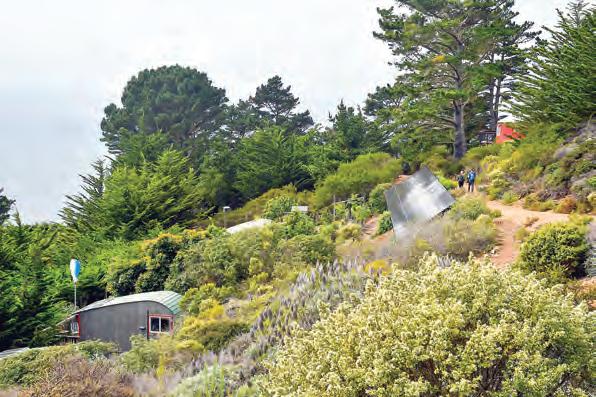
mitage, a Benedictine monastery, remain open for overnight guests. But not everyone knows this. Unless somebody at Google HQ has just made a fix, Google Maps will tell you incorrectly that the hermitage and lodge are beyond the road closure. Nope. They’re both on the south side of the
road closure, accessible to northbound traffic. And they’re both really quiet.
“People come here for silent, self-guided retreats,” said Katee Armstrong, guest ministry specialist at New Camaldoli Hermitage. Its accommodations, high on the slopes above the highway,


include nine single-occupancy rooms and five cottages with kitchenettes ($145 nightly and up).
Meanwhile, on the ocean side of the highway, the Lucia Lodge’s 10 very basic units are visible from the road. Four of them are cabins that go back to the 1930s, when Highway 1 was new.
Some nights, there are only one or two guests, and those guests typically see no hotel employees, because there’s no lobby and the staff is down to a skeleton crew. (The lodge’s restaurant and lobby burned down in 2021.) The nearest restaurant is at Treebones, about 10 miles south.
“We have to have a conversation with every guest who books with us,” said Jessie McKnight, the lodge reservationist. Many “end up canceling once they understand the situation,” she said. “You’re kind of on your own.”
Ad yet, she added, “it’s so rare to experience Big Sur like this. Once the road opens, I think it’s going to be right back to being a zoo.”


























BETH DOOLEY THE MINNESOTA STAR TRIBUNE
Quick and easy, skillet pork chops make a tasty, comforting weeknight dinner.
Be sure to use boneless chops; they’re a breeze to cook when quickly seared over high heat in a heavy cast-iron skillet. The key, of course, is to buy the right chops. Choose pork from a local farm that raises the slower-growing heritage pork breeds outside in the sun. Their meat is blessed with a little marbling; it’s tastier and more succulent than meat from those raised in confinement.
Local co-ops and butchers, as well as many of our grocers’ meat departments, are now carrying great-quality pork. Ask for chops that are three-quarters to an inch thick and 4 to 5 ounces each. Most butchers are happy to cut to order.
The only trick to cooking the chops is to not overcook them. Depending on the thickness, about 3 to 5 minutes per side is often plenty. To round out the meal, add seasonal vegetables to the pan after one side is cooked and the chops have been flipped. The vegetables benefit from the meat’s juices and seasonings as their flavors meld.
This recipe calls for chopped red pepper and kale with a shot of lemon juice to brighten it all. Use your imagination and vary the ingredients depending on the season, your pantry and tastes. Try apples or pears with fennel finished with a dollop of mustard and a drizzle of maple syrup. How about onions and Italian peppers with a splash of balsamic vinaigrette? Take the chops south of the border with hot peppers and cherry tomatoes zipped up with lime.
Leftovers, if you have them, are delicious doused with your favorite barbecue sauce and tucked into a soft, golden bun.

SKILLET PORK CHOPS WITH PEPPERS AND KALE
Serves 2.
This dish rounds out the pork with vegetables that cook alongside in the pan. For some, one chop is just right for two people. Others want the whole thing. Be sure to serve with a good, crusty bread to mop up the juices and a tart green salad on the side. This recipe is easily doubled. From Beth Dooley. 1 or 2 pork chops, each about ¾ to 1 in. thick
Coarse salt
Freshly ground black pepper
1 tbsp. olive oil
2 tbsp. unsalted butter
1 clove garlic, smashed
2 c. chopped kale
1 large red bell pepper, seeded, deveined and chopped Splash of lemon juice, to taste
Generously season the chops with salt and pepper on both sides. Set the chops on a plate and allow to come to room temperature.
In a cast-iron skillet set over medium-high heat, melt the oil and butter together. When the butter foams, add the pork chops and sear until the side begins to turn brown, cooking for about 5 minutes. Flip and add the garlic, kale, red pepper and lemon juice to the pan. Continue cooking until the meat reaches 140 degrees on a meat thermometer, another 4 to 6 minutes. Let the chops and the vegetables rest in the pan for about 3 to 5 minutes. Slice and serve the pork with the vegetables on the side.
Beth Dooley is the author of “The Perennial Kitchen.” Find her at bethdooleyskitchen.com.












Like puzzles? Then you’ll love Sudoku. This mindbending puzzle will have you hooked from the moment you square off, so sharpen your pencil and put your Sudoku savvy to the test!
Sudoku puzzles are formatted as a 9x9 grid, broken down into nine 3x3 boxes. To solve a sudoku, the numbers 1 through 9 must fill each row, column and box. Each number can appear only once in each row, column and box. You can figure out the order in which the numbers will appear by using the numeric clues already provided in the boxes. The more numbers you name, the easier it gets to solve the puzzle!
SOLUTIONS ON PAGE 11








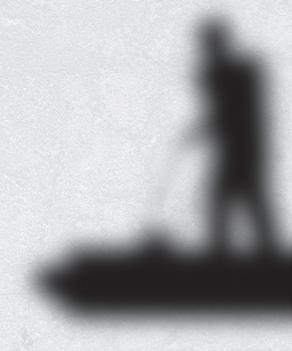










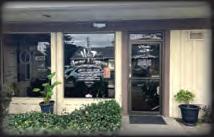




1. Native American people of CA
5. Long periods of time (Brit.)
10. Classroom tool
12. Rods
14. One who renews
16. They start the alphabet
18. Periodical (slang)
19. Smooth singer Cole
20. Dorsal sclerites in insects
22. One from Utah
23. The world of the dead
25. Singer Redding
26. Mafia head
27. Wrongly
28. Unhappy 30. Anger
31. Dark olive black
33. Places to sit and eat
35. Made a mistake
37. Damp
38. Banned fuel type
40. Actor Damon
41. What thespians do
42. A polite address for a woman
44. Disallow
45. Swiss river
48. A banana has one
50. Afrikaans
52. Relative biological effectiveness (abbr.)
53. Agave
55. Journalist Tarbell
56. One-time tech leader
57. Incidentally (abbr.)
58. Intestinal bacterium
63. Loose sheats around the spinal cord 65. Accompanies nook
Vogue
Highly excited
Utilize
Writing utensil
Where rockers work
Becomes less intense
Consume 7. Type of catfish 8. “Horsetown, U.S.A.” 9. Atomic #50 10. The Muse of lyric
poetry
11. Brings back to life
13. Humorous critiques
15. Cool!
17. Worst
18. Wet dirt
21. Useful
23. Hebrew unit of liquid capacity
24. High schoolers’ test
27. Internet device
29. City in India
32. A place to rest
34. Chat responder
35. A way to move on
36. What consumers are given
39. Digital audiotape
40. More (Spanish)
43. Disfigured
44. White (Spanish)
46. Church building
47. Georgia rockers
49. Surgeon’s tool
51. “Much __ about nothing”
54. Make by braiding
59. Local area network
60. Unit of work
61. Indigenous person of Thailand
62. Liquefied natural gas
64. Distance to top
Find the hidden words vertically, horizontally and diagonally throughout the puzzle.
ARCHIPELAGO
BASIN
CONTINENT
DELTA DESERT EQUATOR
EROSION GLACIER HEMISPHERE ISTHMUS LATITUDE LONGITUDE
MOUNTAIN RANGE PENINSULA PLATEAU PRIME MERIDIAN RAINFOREST RIVERS
SOLUTION ON PAGE 11
SAVANNA TOPOGRAPHY TUNDRA VALLEY WATERSHED WEATHER
The month of November has been home to many historical events over the years. Here’s a look at some that helped to shape the world in November 1925.
• The western comedy “Go West” opens on November 1. Silent film legend Buster Keaton stars as “Friendless” and Fatty Arbuckle appears in an uncredited role.
• Sixteen people lose their lives in a small village in Wales when a dam bursts on November 2. The burst comes after five days of heavy rains.
• The Victrola Talking Machine Company
introduces its new electrically-recorded phonograph records on November 2. The records can be played on the Victor Orthophonic Victrola, which cost around $95 in 1925, or the equivalent of nearly $1,700 in 2025.
• The film “The Pleasure Garden” is released on November 3. The release marks the directorial debut of English filmmaker Alfred Hitchcock.
• Italian Socialist Tito Zaniboni is arrested in a room at the Dragoni Hotel on November 4. The hotel is located across the street from the Chigi Palace in Rome, and Zaniboni is accused of renting a room with the intent of shooting Italian Prime Minister Benito Mussolini, who was scheduled to deliver a speech from the palace balcony.
• The National Hockey League awards a franchise to Pittsburgh, Pennsylvania, on November 7. The club is named the Pirates, which is also the name of the city’s baseball team. The franchise moved to Philadelphia for the 1930-31 season before ceasing operations at the end of that campaign.
• The divorce trial of socialite Leonard “Kip” Rhinelander and Alice Jones begins in White Plains, New York, on November 9. At
the urging of his family, Rhinelander sought an annulment of the marriage upon finding out that Jones was biracial. An annulment was never granted, but the marriage ultimately ended in divorce, and neither Rhinelander or Jones ever remarried.
• On November 10, the Archbishop of Canterbury appoints a 12-person committee of six doctors and six clergymen to investigate the veracity of faith healing.
• Louis Armstrong and His Hot Five record their first songs together on November 12. The recordings are considered highly influential for the development of jazz music.
• Polish Prime Minister Wladyslaw Grabski and his cabinet ministers resign on November 13. The mass resignations occur over a difference of opinion with the Bank Polski SA regarding economic issues plaguing the country.
• The American Basketball League opens its inaugural season on November 15. The league is the first national professional basketball league in the United States.
• General Motors purchases British auto manufacturer Vauxhall Motors for $2.5 million on November 16.
• The autopsy of Tutankhamun con-
cludes on November 19. Limited forensic science available at the time, coupled with significant deterioration of the body, limits the findings of the autopsy.
• The luxury train the Orange Blossom Special begins operations on November 21. The train transports travelers from New York City to Miami, Florida.
• The “Hat Law” goes into effect in Turkey on November 25. The law forbids the wearing of non-western headgear, including the fez or the turban.
• A state funeral is held for Queen mother Alexandra at Westminster Abbey in London on November 27. The procession marching behind the casket includes the kings of England, Denmark, Norway, and Belgium.
• The Grand Ole Opry debuts as a radio show on November 28. Fiddler Uncle Jimmy Thompson is the first to perform on the show.
• The new Madison Square Garden on Eighth Avenue between 49th and 50th Streets in Manhattan hosts its first event on November 29. The event is a six-day bicycle race known as “Six Days of New York.”
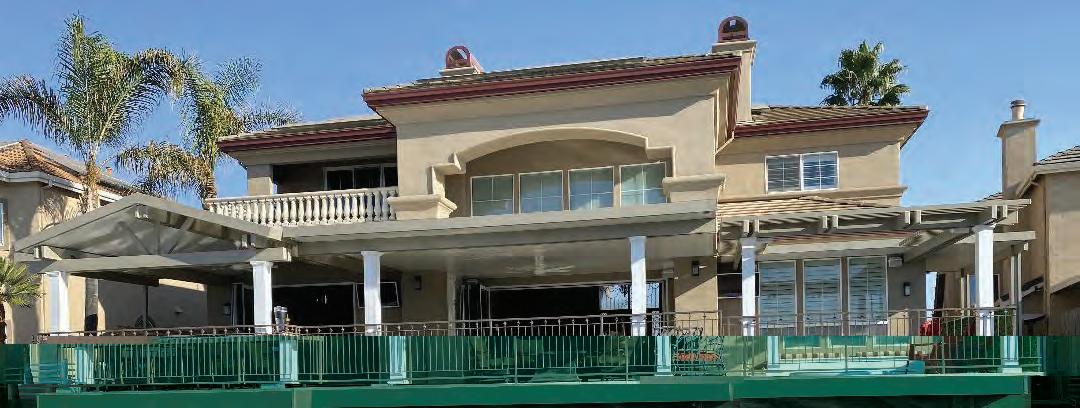





Anumberoftypesofsourcesfoundwithinresidentialneighborhoodsarecapableofproducing enough adult mosquitos to bother not only the residents of one home but a number of homes in the area. These mosquitoes are also capable of transmitting West Nile virus! Water left standing for seven to ten days can produce mosquitoes during warmer weather. There are a numberof simple precautions that can be taken to preventthis from happening...


